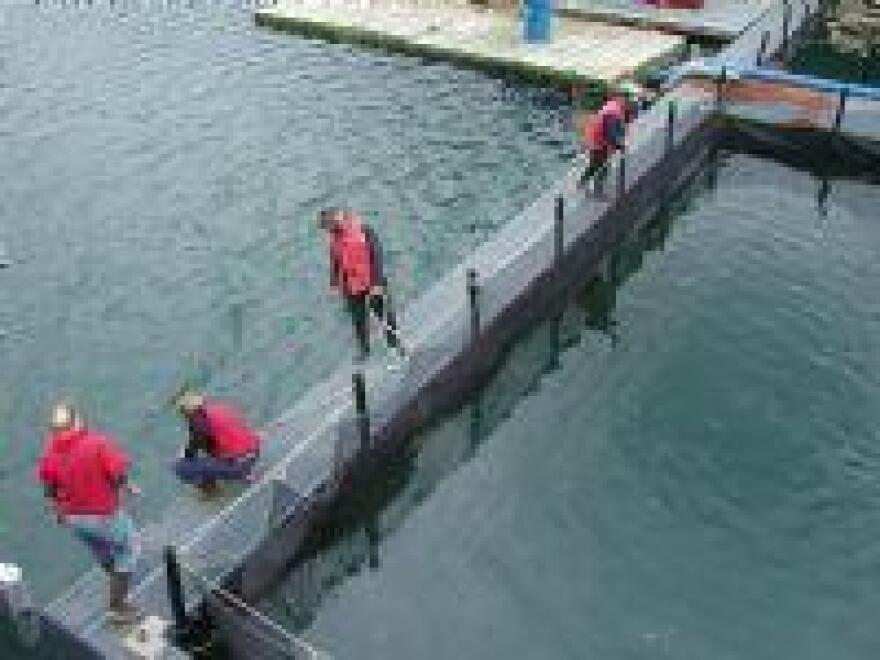Cook Inlet Aquaculture Association has been working to move a majority of its Tutka Bay Lagoon Hatchery operation into the head of Tutka bay for about four years. About 100 people crowded the Alaska Oceans and Islands Visitor Center Monday for a listening session. DNR and Alaska Department of Fish and Game officials got an earful, hearing nearly three hours of testimony from concerned and supportive residents.
Cook Inlet Aquaculture Association has been operating the state-owned Tutka Bay Lagoon Hatchery since 1994, with a goal to release about 100 million pink salmon fry. The association said the lagoon is too small and makes it difficult to harvest returning fish. It applied to move about 25,000 square feet of net pens to the head of Tutka Bay in 2013.
The permit was initially denied and then approved after an appeal. Later, it was rescinded and was approved again by current DNR Commissioner Andy Mack in January.
After hearing from concerned residents, Gov. Bill Walker directed Mack and Fish and Game Commissioner Sam Cotto=en to hold a listening session in Homer. Mac explained at the start of the session the decision was not going to change.
“It’s probably most important to say the decision itself is the binding document,” he said. “If there are any questions, or if one of us says something that’s in opposite of what is in this decision, this decision stands.”
Both locations are in Kachemak Bay State Park and would raise fish for about three months during the season.
Audience members took turns one by one voicing their support or concerns. Several scrutinized the size of the operation, its impact on the viewshed and potential water quality issues.
The park’s former Chief Ranger Rodger McCampbell helped write the 1986 and current 1995 management plan. He said they never expected aquaculture to grow so much.
“The question is in my mind is what do you want your state parks to look like? What type of development, what precedent will this set as the hatchery basically starts to move and grow outside of the footprint that’s existing now, and what other things will come down the road? We did not have a crystal ball in 1986 to look this far into the future. I wish we did.”
However, others say this is exactly what the park was intended for. Former Alaska legislator for the Homer area Clem Tillion helped create the park.
“I also did the critical habitat area later on, and it was nothing detrimental to commercial fisheries would be allowed. They were taking about putting a pulp mill here, but I didn’t like that,” Tillion recalled. “I wanted the environment protected. The thing is I like mariculture because it has to have crystal clear water or it can’t make it. It’s another group that will protect it. The commissioner made the right decision.”
Several argued the impacts of the move are unknown and the decision wasn’t based on science. Area resident Nancy Hillstrand worries that the operation would impact struggling Dungeness crab and shrimp populations.
“Dungeness are going for $5 per pound right now, and we’re putting these pens right in the middle of a Dungeness crab reproductive area,” she explained. “The hatchery closed in 2004 and Fish and Game did some surveys and found that in 2008, 2009, they found substantial numbers of Dungeness crab. We can pretend we think it’s just a fluke, but maybe it’s not a fluke. So has anyone really looked into why these dungeness crab have come back?”
Several fisherman disagreed raising fish in the bay would negatively impact the ecology. Seiner Malcom Mill added that all commercial activity in the park comes at a cost.
“All commercial activity has costs. There’s a cost in having water taxis run in the park. There’s a cost if you have trail development. If we’re marketing the park as a destination for visitors, that has many costs,” Mill listed. “Personally I think these costs are acceptable. It’s part of what allows people to live here and make a living being here.”
Cook Inlet Aquaculture Association still needs one permit from the Alaska Department of Environmental Conservation. Executive director Gary Fandrei said the association hoped to make the move this season.
“We had to delay that because of some reasons with production. We’re hoping to implement the program next year,” he added.
Fandrei hopes that permit will be acquired soon. Some net pens would remain in the lagoon to release fish and their eggs will continue to be harvested for the operation.


